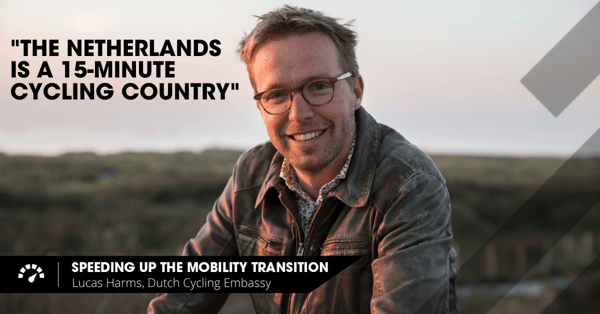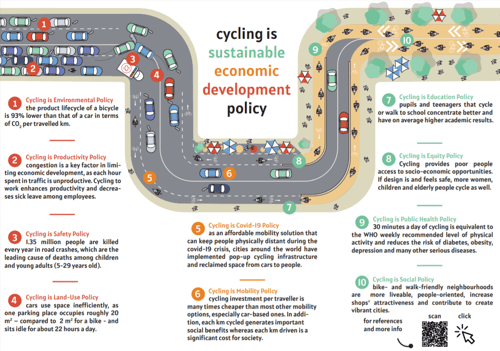Speeding up the mobility transition: Lucas Harms, Dutch Cycling Embassy
With the continuous growth of the population and ongoing urbanization, there are numerous mobility challenges. Sustainability, safety and societal impact are amongst our daily concerns. We need to speed up the mobility transition to keep up with the fast-changing global dynamics, which requires inventive approaches and better solutions. In this series, we share inspiring and innovative cases from all over the world. We spoke to Lucas Harms, Managing Director of the Dutch Cycling Embassy. How does he speed up the mobility transition?
“Were we that blind to our own successes?”
Before Lucas Harms started as Managing Director at the Dutch Cycling Embassy two years ago, he was a researcher for KIM (Knowledge Institute for Mobility) and prior to that at the University of Amsterdam. “ In 2012, Marco te Brömmelstroet (Cycling Professor) and I were among the first who started to conduct research on the social and spatial aspects of mobility focused on cycling. I found it so strange that, until then, hardly any research had been done in a nation that promotes itself as the cycling country of the world. Were we that blind to our own successes?”
The Dutch Cycling Embassy is a foundation; a public-private network for sustainable bicycle-inclusive mobility offering knowledge, experience and experts from private companies, NGOs, research institutions, and national and local governments. “It is not an official embassy; any organisation can apply the name of embassy. We are a team of eight, and connect 82 organisations by organising (online) events, such as ThinkBike workshops and study tours for international delegations.”
“Over 50% of our train trips begin with a bike ride”
“Looking at the other countries, I still think we are doing great when it comes to cycling. Even compared to Denmark and the City of Copenhagen. A recent publication that compares Amsterdam to Copenhagen found that car use and the use of public transport in Copenhagen has increased, and bicycle use has decreased. However, the movements of people on the cycling paths in Amsterdam have increased and will only increase further in the future.”
“In the last couple of years in the Netherlands, we have been working really hard on improving projects such as OV-fiets; the rental bicycle provided by the Dutch national railways at all the train stations. Additionally, we have increased the number and improved the quality of parking spaces for bicycles at train stations. The combination of bicycle and public transport is really important in our country. And it shows! Over 50% of our train trips begin with a bike ride, and 15% of train travel ends with an OV-fiets.”
"In the Netherlands, we seem to take cycling for granted too often"
“Of course, we also have our challenges. In the Netherlands, we seem to take cycling for granted too often. Thalia Verkade is co-author of a Dutch book called Het recht van de snelste created with my former research colleague Marco te Brömmelstroet. She spoke during our 10th anniversary in September and explained it well: ‘Our head start in cycling is sometimes a disadvantage; because the starting point for bicycles is often the car.’
“Other cities sometimes take it a step further in looking at the bicycle from a wider point of view. We tend to see cycling only as a way to fight traffic jams, but it is so much broader than that! It contributes to our way of living, to our environment, to our health and to our safety.”

“Business for shops actually increases when you make streets more attractive for cyclists and pedestrians to access”
“How can you motivate people to cycle? It starts by helping them see and understand the sense of urgency and importance of cycling. And it can increase revenue! One of the critical points made by shop owners who do not want to lose parking spaces for cycling paths is that it would have an effect on their revenue. But a wide body of research shows that business actually increases when you make streets more attractive for cyclists and pedestrians to access.”
“The government can first plant a seed and make people aware through the use of data and research, by showing people the social-economic benefits of investments in cycling, or ‘bikenomics’. For instance, providing facilities for its employees who cycle to work costs six times less than providing parking spaces (Pontificia Universidad Catolica, Lima, Peru). These are some of the examples of reasons why you should invest in cycling:
- Cycling is Land-Use Policy: cars use space inefficiently, as one parking place occupies roughly 20 m2 – compared to 2 m2 for a bike - and sits idle for about 22 hours a day
- Cycling is Environmental Policy: the product lifecycle of a bicycle is 93% lower than that of a car in terms of CO2 per travelled km.
- Cycling is Social Policy: bike- and walk-friendly neighbourhoods are more liveable, people-oriented, increase shops’ attractiveness and contribute to create vibrant cities.”
“Cycling is a powerful transformational tool to create more sustainable, safer, more social, wealthier, healthier and happier cities”
“The Netherlands learned first-hand that cycling is not only a humble mode of transportation but also very powerful transformational tool to create more sustainable, safer, more social, wealthier, healthier and happier cities. The Dutch Cycling Embassy can help organisations from abroad to show you around or help to connect and learn. Our approach is Experience, Think, Act and Learn. There are a few places I proudly visit or projects I like to point out, when I guide a delegation of ministers from abroad:
- The parking garage or ‘Bicycle Cathedral’ at Utrecht Centraal Station
- “New cycling city” in Houten where the bicycle was the main player in urban planning
- Daphne Schippers Bridge: built on a roof of a school only for cyclists as a connection to the inner city of Utrecht
- Traffic education for children
- Our urban planning based on the bicycle with segregated cycle paths or car-free areas
“Overall, there is still a lot of car use in European cities. I really enjoy seeing the visions of other European cities such as Rome, and how it improved by adding car-free zones. These are often inspired by Dutch examples such as Amsterdam. From inspiration you can start a pilot project by improving a street and showing the inhabitants it really works; to demonstrate that this has a large added value to the liveability. By letting them ‘taste’ or even experience it, they can be convinced.”
“In the Netherlands, cycling is in our DNA. We grow up with it. Where this is not the case, offering people the opportunity to use the bicycle more often, facilitating and letting them experience it, can give it a good push. In Bangalore, the Bicycle Mayor set up a platform for companies to monitor the amount of kilometres cycled to the office. Every company has its own bicycle ambassador, and all the companies in the city are competing against each other. This really fits the tech mindset of the city and its inhabitants.”
“The Netherlands already is a 15-minute cycling country, but we do not frame it that way because it is self-evident”
“The future of mobility is the bicycle, especially in urban mobility. The European Green Deal will undoubtedly force us to question the way we live. As Frans Timmermans pointed out, by 2030 every European city should be carbon neutral, and the bicycle can really help to accomplish that! A great example for me is the City of Paris and Mayor Anne Hidalgo. It is, again, a new way of framing the bicycle. For Paris, the bicycle is a means to create a 15-minute city. The Netherlands already is a 15-minute cycling country, but we do not frame it that way because it is self-evident.”
“In places where not everyone has access to or the possibility of owning a bicycle, shared bicycles can really offer a solution. In Shanghai, shared bicycles proved to be a great success for people to change the way they move. A challenge that comes with it, is to monitor all the forms of transport we have and the space it requires on or off the streets.”
“For us, as the Dutch Cycling Embassy, there are many opportunities in countries immediately around us such as Belgium, France and Germany. Billions are invested to improve cycling and I look forward to helping them connect and learn. But also further away, such as in the United States, more and more cities are making themselves more cycle-friendly. We have been helping Los Angeles, for example, where they combine cycling with public bus transit, also explained during one of the Intertraffic ON AIR episodes. I really look forward to seeing the twinkle in international ministers’ eyes, when they see what an impressive cycling country we are!”
Share your story
Do you have an innovation, research results or an other interesting topic you would like to share with the professionals in the infrastructure, traffic management, safety, smart mobility and parking industry? The Intertraffic website and social media channels are a great platform to showcase your stories!
Please contact our Sr Brand Marketing Manager Carola Jansen-Young.
Are you an Intertraffic exhibitor?
Make sure you add your latest press releases to your Company Profile in the Exhibitor Portal for free exposure.







